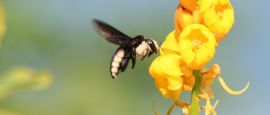The Bateke Plateau, comprising savannah and forest galleries shaped by tumultuous rivers is a known wildlife hotspot. Creatures include forest elephants, buffalos, river hogs, gorillas, panthers, crocodiles, monkeys and parrots. Alternatively, traverse the enchanting Mayumba, a thin strip of land set between sea and lake, where up to 3,000 humpback whales can be seen between July and September.
Gabon things to see and do
Gabon’s former president, Omar Bongo, ordered the construction of the Palais Presidential on Libreville’s waterfront in the 1970s. Costing an estimated US$800 million, it came close to bankrupting the newly independent nation. Even though visitors are not permitted inside the heavily-guarded palace, you are able to view its spectacular modernist design and take photographs from outside.
The best beaches for peace and quiet are the deserted beaches of Pointe Denis and Ekwata in Gabon’s north, and Mayumba and Sette Cama in the south. Both Libreville and Port Gentil have beaches equipped for waterskiing, while Cap Estérias, 35km (22 miles) from Libreville, is a popular water sports centre at weekends. Perroquet and Pointe Denis offer good skin diving.
Popular among European visitors, many of Gabon’s rivers and lakes offer excellent catches, though local fishermen can find the largest variety of fish along the country’s 900km (550 mile) Atlantic coast and in the numerous lagoons located at the mouth of the River Ogooué. Equipment can be hired at Port Gentil.
Don't miss the hustle and bustle of Mount Bouet Market, Libreville’s largest market. The hundreds of stalls selling food, textiles, household goods and traditional medicines funnel visitors into narrow maze-like alleys. On the market’s outskirts is a more relaxed shopping district, predominantly selling printed clothes.
The National Museum of Art and Traditions in Libreville, a short stroll from the Presidential Palace, contains some of the most beautiful wood carvings in Africa, especially the indigenous Fang style of carving, which influenced Picasso's figures and busts. The photographs of Gabon in bygone days, and the musical instruments are also worth some time.
Easily accessible in the centre of the country, Lopé National Park is Gabon's largest. Its landscape, containing a mixture of savannah and dense forest, provide habitats for lowland gorillas, chimpanzees and forest elephants, as well as a variety of other primates, large mammals and around 350 species of bird which can all be tracked on foot or by car.
Spanning the Ogooué River, Lambaréné was brought to the world’s attention by the lifelong dedication of Albert Schweitzer, a German-French doctor and world-class musician awarded the Nobel Peace Prize in 1952. Still functioning, the Schweitzer Hospital includes a small museum dedicated to the doctor created from his basic living accommodation.
The villages of M'Bigou and Eteke in Gabon’s south are famed for the quality of the normally light grey soapstone extracted from the surrounding hills, and the carvings produced by the craftsmen there that result. The nearby gold mines are also well worth a visit.
The winding route leading from Libreville to the beach of Cap Estérias 35km (22 miles) north offers a chance to explore Gabon’s natural beauty, such as the forest of giant trees you will pass through. Rocks abound with sea urchins, oysters and lobsters. Cap Estérias itself is a safe place to swim in the ocean.
The wooden church of St Michael of Nkembo in Libreville is supported by 31 tall and heavily-carved wooden columns, each depicting a scene from Christian and African legend, that were created by a blind Gabonese craftsman. A hall-like structure in comparison to Libreville’s other European-style churches, the rich exterior painting depicts St George killing the dragon.
Do you have any Feedback about this page?
© 2025 Columbus Travel Media Ltd. All rights reserved. No part of this site may be reproduced without our written permission, click here for information on Columbus Content Solutions.








 You know where
You know where